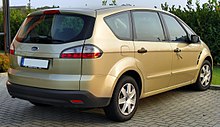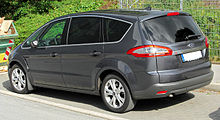Ford C Max 2007 Titanium
Motor vehicle
| Ford S-Max | |
|---|---|
 | |
| Overview | |
| Manufacturer | Ford Europe |
| Production | 2006–present |
| Body and chassis | |
| Class | Large MPV (M) |
| Body style | 5-door MPV |
| Related | Ford Galaxy Ford Mondeo |
The Ford S-Max (stylized as Ford S-MAX) is a mid-size/large MPV produced by Ford Europe for the European market. Ford also describes the S-Max as an SAV (sports activity vehicle). Introduced at the 2006 Geneva Motor Show, the S-Max went on sale alongside the new generation Galaxy in June 2006.
The S-Max is intended to be sporty as a saloon, and spacious as an MPV. It shows inspiration from the seven-seater large MPV Galaxy, and compact MPV Ford C-Max. The S-Max has received many positive reviews and awards, and was voted European Car of the Year 2007 on 13 November 2006. Ford had plans to sell the S-Max in Japan under the then subsidiary brand Mazda, but they are no longer viable since the latter's split.
Features [edit]
The S-Max was the first vehicle in Ford's lineup to feature their Kinetic Design styling. The Kinetic Design scheme includes angular headlights, twin trapezoidal grilles, and large wheelarches.
It comes with heated front and back windscreens, parking sensors, aux input and dual climate control as standard. One major selling point of the S-Max is its "Fold Flat System". This design allows the second and third-row seats to fold seamlessly into the floor, leaving extra storage space.
First generation (2006) [edit]
Motor vehicle
| First generation | |
|---|---|
 Ford S-Max (pre-facelift) | |
| Overview | |
| Production | 2006–2014 |
| Assembly |
|
| Designer | David Hilton |
| Body and chassis | |
| Platform | Ford EUCD platform |
| Dimensions | |
| Wheelbase | 2,850 mm (112.2 in) |
| Length | 4,770 mm (187.8 in) |
| Width | 1,885 mm (74.2 in) |
| Height | 1,660 mm (65.4 in) |
| Curb weight | 1,743 kg (3,843 lb) |
Models [edit]

Ford S-Max (Pre-facelift)
For the English speaking markets there are three derivatives of the S-Max: Edge, Zetec, and the high-end Titanium. Ford has stated that around sixty percent of all S-Max buyers choose Titanium specification. Continental trim levels are Trend, Titanium and the top of the line Titanium S.
In March 2008, a 2.2L 175 PS TDCi common rail diesel was added to Titanium series and delivers acceleration from 0-62 mph in 9.0 seconds. In September 2008, the popular 2.0 140 PS TDCi manual engine was offered with a CO2 of 159 g/km. The S-Max Trend debuted in China in 2010. The Trend is basically a normal S-Max, but without the back row of seats. The idea is to make it more affordable, and to give more storage space to people who might want it.
Powertrain [edit]
All S-Maxes use versions of the Duratorq or Duratec engines. The S-Max uses a five- speed or six- speed manual transmission, and a six-speed automatic option.
| Engine | Power | Transmission |
|---|---|---|
| 1.8 TDCi | 101 PS (101 hp) | 5 Speed Manual |
| 1.8 TDCi | 125 PS (123 hp) | 5 Speed Manual |
| 1.8 TDCi | 125 PS (123 hp) | 6 Speed Manual |
| 2.0 TDCi | 115 PS (113 hp) | 6 Speed Manual |
| 2.0 TDCi | 140 PS (143 hp) | 6 Speed Manual |
| 2.0 | 145 PS (138 hp) | 5 Speed Manual |
| 2.0 145 Flex Fuel | 130 PS (128 hp) | 5 Speed Manual |
| 2.2 TDCi | 175 PS (173 hp) | 6 Speed Manual |
| 2.3 | 160 PS (158 hp) | 6 Speed Automatic |
| 2.5 (shared with the Ford Focus ST) | 220 PS (217 hp) | 6 Speed Manual |
- This vehicle has also been converted to use an aftermarket conversion hybrid powertrain: Langford Performance Engineering 'Whisper' powertrain
New petrol engines for the 2010/2011 models:
- 1.6 STCi EcoBoost, 6 Speed Manual, 160 PS
- 2.0 STCi EcoBoost, Powershift, 203 PS
Engines available for the 2012 Models:
- 1.6T 160 PS EcoBoost (Start/Stop), 6 Speed Manual
- 2.0 203 PS EcoBoost, PowerShift Auto
- 2.0 240 PS EcoBoost, PowerShift Auto
- 1.6 TDCi 115 PS (Start/Stop), 6 Speed Manual
- 2.0 TDCi 140 PS, 6 Speed Manual
- 2.0 TDCi 140 PS, PowerShift Auto
- 2.0 TDCi 163 PS, 6 Speed Manual
- 2.0 TDCi 163 PS, PowerShift Auto
- 2.2 TDCi 200 PS, 6 Speed Manual
- 2.2 TDCi 200 PS, Automatic
[3]
Safety [edit]

Ford S-Max Titanium S (facelift)

The Ford S-Max incorporates no breakthrough safety features, but it has received a 5-star/36-point (Best in Class) rating from the Euro NCAP.
The S-Max's safety features include the Intelligent Protection System (IPS) which combines a body structure optimised for strength and crashworthiness with restraint equipment and driver aids that help avoid an accident and features that lessen the likelihood of injuries in an impact. It has many modern airbags, including a knee airbag and a thorax airbag.
S-Max's also have an advanced neck protection system, three point seat belts, optimised pre-tensioners, load limiters, anti-submarining seat subframes, a collapsible steering system and safety pedals. For handling it has an Anti-Lock Braking System (ABS) along with Electronic Brakeforce Distribution (EBD) and standard Electronic Stability Program (ESP) system.
Media [edit]
The high performance version Ford S-Max was reviewed on Top Gear (Series 8, Episode 7) against the similar spec Vauxhall Zafira and the Mercedes B200. The S-Max was the most affordable, yet was described as having the best interior and exterior, and being the most comfortable. The presenters, James May and Richard Hammond, also considered it to be the most practical. Overall, they praised the car and declared it to be the best value for money out of the three.[4]
Second generation (2015) [edit]
Motor vehicle
| Second generation | |
|---|---|
 | |
| Overview | |
| Production | 2015–present |
| Assembly | Spain: Almussafes (Ford Valencia Plant) |
| Designer | Claudio Messale[5] |
| Body and chassis | |
| Platform | Ford CD4 platform |
| Powertrain | |
| Engine | 1.5-liter EcoBoost I4 (petrol) 2.0-liter EcoBoost I4 (petrol) 2.0-liter Duratorq I4 (diesel; 2015 - 2019) 2.0-liter EcoBlue I4 turbo (diesel; 2019 - Present) 2.0-liter EcoBlue I4 twin-turbo (diesel; 2019 - Present) |
| Dimensions | |
| Wheelbase | 2,850 mm (112.2 in) |
| Length | 4,796 mm (188.8 in) |
| Width | 1,916 mm (75.4 in) |
| Height | 1,655 mm (65.2 in) |
| Curb weight | 1,743 kg (3,843 lb) |
The second generation was first presented at the 2014 Paris Motor Show.

After its sibling, Ford Galaxy, was being presented at the 2015 Geneva Motor Show, Ford decided to put it into production in late 2015.
It comes with the same engines as the Galaxy, Mondeo and Edge, which consist of one diesel (in four states of tune) and two petrols. The 1.5 SCTi Ecoboost has 160 hp, and the 2.0 SCTi has 240 hp, the latter can only be had with the Ford 6F automatic transmission. All the diesels average over 50mpg - the best is the 2.0 TDCi Duratorq 120, which produces 57mpg.
Both the 2.0 TDCi 150 and 180 versions come with either a six speed manual or the Powershift, the latter can also be specced with AWD. The final model, the Bi-Turbo 2.0 TDCi 210 comes with the Powershift Gearbox only, and hits 0 to 62 in under nine seconds. The trim levels are similar to any Ford, and mirror those found in the Galaxy, Mondeo and Edge, including Zetec, Titanium and Titanium Sport also an executive spec Vignale is available.
Engine specifications [edit]
| Model | Year(s) | Displacement | Fuel Type | Power | Torque | 0–100 km/h (0–62 mph) | CO2 Emissions |
|---|---|---|---|---|---|---|---|
| 1.5 EcoBoost 160HP | 2015– | 1,498 cc (91.4 cu in) | Petrol | 159 PS (117 kW; 157 bhp) | 240 N⋅m (177 ft⋅lbf) | 9.9 s | 149 g/km |
| 2.0 EcoBoost 240HP Auto | 2015– | 1,999 cc (122.0 cu in) | Petrol | 241 PS (177 kW; 238 bhp) | 345 N⋅m (254 ft⋅lbf) | 8.4 s | 174 g/km |
| Model | Year(s) | Displacement | Fuel Type | Power | Torque | 0–100 km/h (0–62 mph) | CO2 Emissions |
|---|---|---|---|---|---|---|---|
| 2.0 TDCi 120HP | 2015– | 1,997 cc (121.9 cu in) | Diesel | 120 PS (88 kW; 118 bhp) | 310 N⋅m (229 ft⋅lbf) | 13.4 s | 129 g/km |
| 2.0 TDCi 150HP | 2015– | 1,997 cc (121.9 cu in) | Diesel | 150 PS (110 kW; 148 bhp) | 350 N⋅m (258 ft⋅lbf) | 10.8 s | 129 g/km |
| 2.0 EcoBlue TDCi 150HP PowerShift | 2015– 2019– | 1,997 cc (121.9 cu in) | Diesel | 150 PS (110 kW; 148 bhp) | 350 N⋅m (258 ft⋅lbf) | 10.8 s | 139 g/km |
| 2.0 EcoBlue TDCi 150HP AWD | 2015– 2019– | 1,997 cc (121.9 cu in) | Diesel | 150 PS (110 kW; 148 bhp) | 350 N⋅m (258 ft⋅lbf) | 12.1 s | 139 g/km |
| 2.0 EcoBlue TDCi 180HP | 2015–2019 2019– | 1,997 cc (121.9 cu in) | Diesel | 179 PS (132 kW; 177 bhp) | 400 N⋅m (295 ft⋅lbf) | 9.7 s | 129 g/km |
| 2.0 EcoBlue TDCi 180HP PowerShift | 2015–2019 2019– | 1,997 cc (121.9 cu in) | Diesel | 179 PS (132 kW; 177 bhp) | 400 N⋅m (295 ft⋅lbf) | 9.5 s | 139 g/km |
| 2.0 EcoBlue TDCi 180HP AWD PowerShift | 2015–2019 2019– | 1,997 cc (121.9 cu in) | Diesel | 179 PS (132 kW; 177 bhp) | 400 N⋅m (295 ft⋅lbf) | 10.5 s | 149 g/km |
| 2.0 EcoBlue TDCi Bi-turbo 210HP PowerShift | 2019– | 1,997 cc (121.9 cu in) | Diesel | 209 PS (154 kW; 206 bhp) | 450 N⋅m (332 ft⋅lbf) | 8.8 s | 144 g/km |
References [edit]
- ^ Ford S-Max in China
- ^ Ford S-MAX
- ^ 20 Oct 2012. "S-MAX Models". Ford. Retrieved 2012-10-20 .
- ^ 20 Oct 2012. "Mpv reviews". topgear.com. Archived from the original on 2012-08-25. Retrieved 2012-10-20 .
- ^ "FORD S-MAX: THE DESIGN STORY".
- ^ "Ford S Max 2015 - Technical specifications, size dimensions, fuel economy". ultimatespecs.com.
- ^ "Ford S Max 2015 - Technical specifications, size dimensions, fuel economy". ultimatespecs.com.
External links [edit]
| | Wikimedia Commons has media related to Ford S-Max. |
- Official website
Source: https://en.wikipedia.org/wiki/Ford_S-Max


Tidak ada komentar: